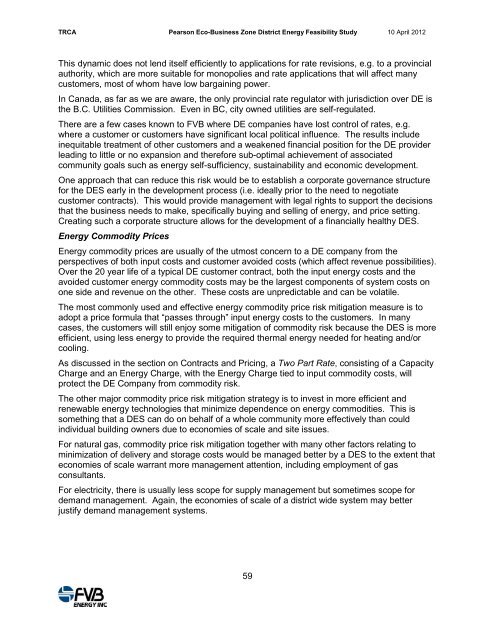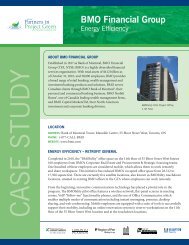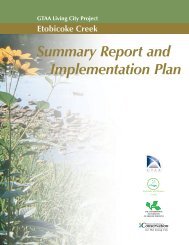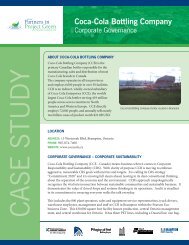Project Green District Energy Feasibility Study - Partners in Project ...
Project Green District Energy Feasibility Study - Partners in Project ...
Project Green District Energy Feasibility Study - Partners in Project ...
You also want an ePaper? Increase the reach of your titles
YUMPU automatically turns print PDFs into web optimized ePapers that Google loves.
TRCA Pearson Eco-Bus<strong>in</strong>ess Zone <strong>District</strong> <strong>Energy</strong> <strong>Feasibility</strong> <strong>Study</strong> 10 April 2012<br />
This dynamic does not lend itself efficiently to applications for rate revisions, e.g. to a prov<strong>in</strong>cial<br />
authority, which are more suitable for monopolies and rate applications that will affect many<br />
customers, most of whom have low barga<strong>in</strong><strong>in</strong>g power.<br />
In Canada, as far as we are aware, the only prov<strong>in</strong>cial rate regulator with jurisdiction over DE is<br />
the B.C. Utilities Commission. Even <strong>in</strong> BC, city owned utilities are self-regulated.<br />
There are a few cases known to FVB where DE companies have lost control of rates, e.g.<br />
where a customer or customers have significant local political <strong>in</strong>fluence. The results <strong>in</strong>clude<br />
<strong>in</strong>equitable treatment of other customers and a weakened f<strong>in</strong>ancial position for the DE provider<br />
lead<strong>in</strong>g to little or no expansion and therefore sub-optimal achievement of associated<br />
community goals such as energy self-sufficiency, susta<strong>in</strong>ability and economic development.<br />
One approach that can reduce this risk would be to establish a corporate governance structure<br />
for the DES early <strong>in</strong> the development process (i.e. ideally prior to the need to negotiate<br />
customer contracts). This would provide management with legal rights to support the decisions<br />
that the bus<strong>in</strong>ess needs to make, specifically buy<strong>in</strong>g and sell<strong>in</strong>g of energy, and price sett<strong>in</strong>g.<br />
Creat<strong>in</strong>g such a corporate structure allows for the development of a f<strong>in</strong>ancially healthy DES.<br />
<strong>Energy</strong> Commodity Prices<br />
<strong>Energy</strong> commodity prices are usually of the utmost concern to a DE company from the<br />
perspectives of both <strong>in</strong>put costs and customer avoided costs (which affect revenue possibilities).<br />
Over the 20 year life of a typical DE customer contract, both the <strong>in</strong>put energy costs and the<br />
avoided customer energy commodity costs may be the largest components of system costs on<br />
one side and revenue on the other. These costs are unpredictable and can be volatile.<br />
The most commonly used and effective energy commodity price risk mitigation measure is to<br />
adopt a price formula that “passes through” <strong>in</strong>put energy costs to the customers. In many<br />
cases, the customers will still enjoy some mitigation of commodity risk because the DES is more<br />
efficient, us<strong>in</strong>g less energy to provide the required thermal energy needed for heat<strong>in</strong>g and/or<br />
cool<strong>in</strong>g.<br />
As discussed <strong>in</strong> the section on Contracts and Pric<strong>in</strong>g, a Two Part Rate, consist<strong>in</strong>g of a Capacity<br />
Charge and an <strong>Energy</strong> Charge, with the <strong>Energy</strong> Charge tied to <strong>in</strong>put commodity costs, will<br />
protect the DE Company from commodity risk.<br />
The other major commodity price risk mitigation strategy is to <strong>in</strong>vest <strong>in</strong> more efficient and<br />
renewable energy technologies that m<strong>in</strong>imize dependence on energy commodities. This is<br />
someth<strong>in</strong>g that a DES can do on behalf of a whole community more effectively than could<br />
<strong>in</strong>dividual build<strong>in</strong>g owners due to economies of scale and site issues.<br />
For natural gas, commodity price risk mitigation together with many other factors relat<strong>in</strong>g to<br />
m<strong>in</strong>imization of delivery and storage costs would be managed better by a DES to the extent that<br />
economies of scale warrant more management attention, <strong>in</strong>clud<strong>in</strong>g employment of gas<br />
consultants.<br />
For electricity, there is usually less scope for supply management but sometimes scope for<br />
demand management. Aga<strong>in</strong>, the economies of scale of a district wide system may better<br />
justify demand management systems.<br />
59













